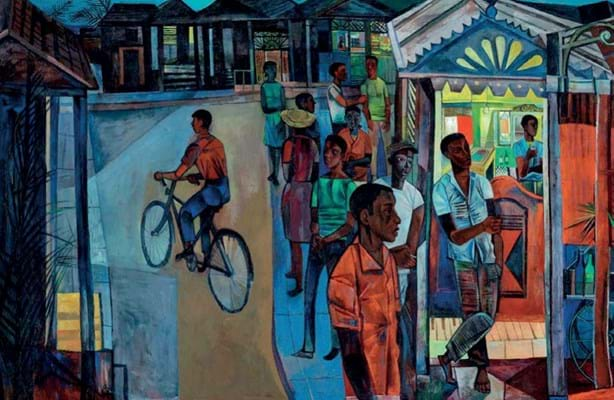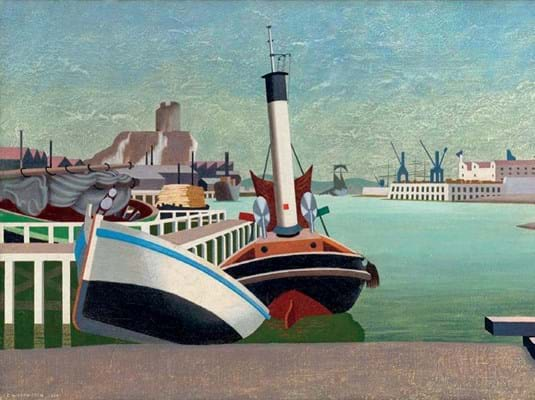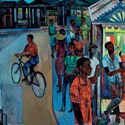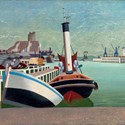Art market
HAS there ever been a better time to sell Modern British art? Results from the latest Mod Brit series in London would suggest not.
A bumper hammer total of £23.5m from the trio of main sales held in the major London rooms and high selling rates dispelled any last remnants of the timid market of old.
Yes, the market has been upbeat for some time, but it found a new gear in November. Artist records continued to tumble just weeks after Sotheby’s Bowie/Collector sales went over expectations and achieved more than 30 auction records for new and established British artists.
Reported bidding from Asia at this series also firmed up the claim of increasing ‘global’ appeal for Mod Brit material.
Underlying all this has been the quality of the consignments, and the sector is fortunate that, for the moment at least, a steady stream exists to meet the snowballing demand.
Highest-ever total
Christie’s (25/20/12% buyer’s premium) led the way with plenty of spirited bidding at its £12.1m evening sale on November 23 in King Street.
Only four of the 38 lots failed to sell, helping to push the annual total for Mod Brit sales at Christie’s in 2016 to its highest ever at £68m.
Topping the sale was an abstract composition by Mod Brit favourite Ben Nicholson (1894-1982).
The auction house had high hopes for April 57 (Arabia 2), placed on the catalogue cover, and for good reason. Painted during the artist’s most sought-after decade, the 4ft x 3ft 6in (1.22 x 1.06m) pencil and oil on board from 1957 is part of a large body of ‘symphonic’ abstract still-lifes considered the high point of the artist’s career.
One of them, Val d’Orcia, is now in the Tate Britain gallery in London while another, Boutique fantastique, set a landmark price for Nicholson when it sold at Christie’s back in June 1990 for £1.1m.
Furthermore, April 57 (Arabia 2) had never been on the auction block before, remaining in the same private European collection for half a century.
Given an appetising £600,000- 800,000 guide, it was eventually hammered down to a UK buyer at £3.2m, easily surpassing the previous high of €3.31m (£2.64m) including premium for Violin et guitar at Christie’s Paris in 2012.
Another seminal work offered at Christie’s was John Minton’s (1917-57) lively large-scale canvas Jamaican Village.A landmark price for Nicholson when it sold at Christie’s back in June 1990 for £1.1m.
Furthermore, April 57 (Arabia 2) had never been on the auction block before, remaining in the same private European collection for half a century.
Given an appetising £600,000- 800,000 guide, it was eventually hammered down to a UK buyer at £3.2m, easily surpassing the previous high of €3.31m (£2.64m) including premium for Violin et guitar at Christie’s Paris in 2012.
Another seminal work offered at Christie’s was John Minton’s (1917-57) lively large-scale canvas Jamaican Village.
Minton, who is fast becoming a highly bankable artist at auction, painted the 5ft x 11ft 10in (1.52 x 3.62m) oil on canvas on the Caribbean island in 1951, exhibiting it the same year at the Royal Academy in London.
Although the artist probably initially intended it for a wall in a bar or club, he gave it to his friend Prof John Norris Wood, a distinguished natural history illustrator who taught at the Royal College of Art. Over the next 65 years, it remained largely unseen in Wood’s barn by all but a few including the late art critic Brian Sewell, who described it as ‘splendid’ and even tried to buy it.
Given a light clean by Christie’s before the sale, it was entered with a £100,000-150,000 estimate, a confident guide given that only one other six-figure price has ever been fetched for the artist (Jamaican Market, also from 1951, took £155,000 at Bonhams in June). It paid off, however, as a UK private buyer, bidding via dealer Charles Beddington, secured the canvas for a record £240,000.
Another record was achieved for a 18in x 3ft 1in (46 x 94cm) Surrealist style harbour scene by Edward Wadsworth (1889-1949).
Titled Imaginary Harbour I, the rare tempera painting laid on panel from 1934 depicts an eerie harbour, devoid of people, with empty ships floating weightlessly on the water.
While prints by Wadsworth appear with some regularity at auction, paintings from this period are much rarer. This example had not been on the market for several decades and was last bought by Robert Harling, a friend of Ian Fleming and an astute Mod Brit collector, from the Leicester Galleries in London.
Guided at £80,000-120,000, it sold for £160,000 to a UK collector on the phone. The price surpasses the previous £150,000 high, held for 24 years by The Cattewater, Plymouth Sound at Sotheby’s.
A First World War sketch by William Roberts (1895-1980), depicting a group of joyous and boisterous young soldiers as they leave for the front for the first time, took £310,000 against an £80,000-120,000 estimate.
The Leave Train, a 10 x 14in (25 x 35cm) ink and watercolour, was consigned from the property of a gentleman and was formerly in the collection of the English writer Arnold Bennett.
Dating from 1916, the drawing was described by the auctioneers as one of the “fullest examples of this period to come to auction”. Roberts, who went on to become an official war artist in 1918, is known for the raw honesty of his sketches and drawings executed during his gruelling two-year stretch at the front.

















